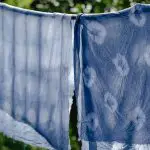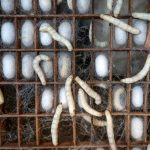Are you considering using denim for your grow bag fabric? Find out if it’s the right choice for you!
In this article, we’ll explore the pros and cons of denim as a grow bag fabric, its durability, water retention and drainage capabilities, and how it compares to other fabrics.
We’ll also provide tips on caring for denim grow bags and choosing the right denim for your needs.
So, let’s dive in and discover how well denim really works for grow bag fabric!
Table of Contents
Pros of Using Denim for Grow Bag Fabric
One of the pros of using denim for grow bag fabric is that it is durable and long-lasting. Denim is known for its strength and resilience, making it an excellent choice for a material that needs to withstand the elements and constant use. Whether you are growing vegetables, herbs, or flowers, you can count on denim to hold up well over time.
Another advantage of using denim for grow bag fabric is its water retention properties. Denim has the ability to retain moisture, which is essential for the health and growth of your plants. It helps to prevent the soil from drying out too quickly, ensuring that your plants receive a steady supply of water. This is especially important in hot climates or during dry spells when water can evaporate rapidly.
Furthermore, denim is a sustainable option for grow bag fabric. By repurposing old jeans or using fabric made from recycled denim, you are reducing waste and contributing to a more eco-friendly gardening practice.
Cons of Using Denim for Grow Bag Fabric
Avoid using denim for your grow bag fabric due to its limitations. While denim may seem like a trendy and durable choice, it is not the best option for your plants. Here are some cons and limitations of using denim for grow bags:
-
Poor drainage: Denim fabric tends to retain water, which can lead to overwatering and root rot. This can be detrimental to the health and growth of your plants.
-
Lack of breathability: Denim is not a breathable fabric, which means it can trap heat and moisture inside the grow bag. This can create a humid environment that promotes the growth of fungi and bacteria, potentially harming your plants.
-
Limited durability: Despite its reputation for being sturdy, denim is not as durable as other fabrics commonly used for grow bags. Over time, denim may fray or tear, compromising the structural integrity of the bag and potentially causing damage to your plants.
-
Limited size options: Denim grow bags are often available in limited sizes and shapes. This can restrict your options when it comes to choosing the right size for your plants and their root systems.
Considering these cons and limitations, it is advisable to explore alternative fabric options that provide better drainage, breathability, durability, and flexibility for your plants’ needs.
Durability of Denim as a Grow Bag Fabric
Consider using a different fabric for your grow bag that is known for its durability. When it comes to choosing the right fabric for your grow bags, durability is an important factor to consider. Denim and burlap are two popular choices, but they differ in terms of their durability and affordability.
Denim, a sturdy and long-lasting fabric, is known for its durability. It can withstand heavy use and is resistant to tearing and fraying. This makes it an excellent choice for grow bags, as they need to withstand the weight of the soil and the pressure exerted by the growing plants. Additionally, denim is also resistant to UV rays, which means it won’t degrade or fade easily when exposed to sunlight.
On the other hand, burlap is a more affordable option compared to denim. It is made from natural fibers, which makes it biodegradable and eco-friendly. However, burlap is not as durable as denim. It tends to break down over time, especially when exposed to moisture and sunlight. This means that you may need to replace your burlap grow bags more frequently, which can add to the overall cost in the long run.
Water Retention and Drainage in Denim Grow Bags
To ensure proper water retention and drainage in your denim grow bags, make sure to create sufficient drainage holes at the bottom. This will allow excess water to flow out and prevent waterlogging, which can be detrimental to plant growth.
Here are some tips to optimize water conservation and promote healthy plant growth in your denim grow bags:
-
Choose the right soil: Use a well-draining soil mix that retains moisture while allowing excess water to drain through. Avoid using heavy clay or compacted soil, as it can hinder drainage.
-
Add organic matter: Incorporate compost or organic matter into the soil mix to improve water retention. This will help the soil hold onto moisture without becoming waterlogged.
-
Mulch the surface: Applying a layer of organic mulch on top of the soil will help conserve moisture by reducing evaporation. It also acts as a barrier, preventing weed growth and maintaining a more stable soil temperature.
-
Water deeply and infrequently: Instead of frequent shallow watering, water your plants deeply but less often. This encourages plants to develop deeper root systems, allowing them to access water from lower soil layers.
Comparing Denim to Other Fabrics for Grow Bags
When it comes to choosing fabric for grow bags, it’s important to consider the pros and cons of denim versus synthetic fabrics.
Denim is known for its durability, making it a reliable option for long-term use.
On the other hand, synthetic fabrics may offer better breathability, allowing air to circulate more easily around plant roots.
Ultimately, the choice between denim and synthetic fabrics will depend on your specific gardening needs and preferences.
Denim Vs. Synthetic Fabrics
You might be wondering how denim compares to synthetic fabrics for grow bag fabric. Well, let’s take a closer look at the pros and cons of denim compared to plastic and jute:
-
Denim vs. Plastic:
Denim is a more sustainable option compared to plastic. It is biodegradable and can be composted at the end of its life.
Denim provides better breathability for the plants, allowing for proper air circulation and moisture control. -
Denim vs. Jute:
Denim is a more durable choice than jute. It can withstand frequent use and is less prone to tearing or fraying.
Denim offers better insulation properties, keeping the roots protected from extreme temperatures.
Durability of Denim
If you’re looking for a long-lasting option, denim is a great choice due to its durability. Denim fabric is known for its strength and wearability, making it an excellent choice for a variety of uses.
Whether you’re looking for a fabric that can withstand heavy use or one that will hold up well over time, denim is a reliable option. Its tightly woven construction and sturdy fibers make it resistant to tearing and fraying, ensuring that it can withstand the rigors of everyday wear.
Additionally, denim fabric is known for its ability to maintain its shape and structure, even after repeated washings. So if you’re in need of a fabric that combines style and durability, denim is a smart choice.
Breathability of Different Fabrics
Cotton is a breathable fabric that allows air to circulate, keeping you cool and comfortable. When it comes to gardening, the fabric you choose for your grow bags can have a significant impact on plant growth. Denim, a type of cotton fabric, offers several advantages for gardening purposes.
Advantages of denim in gardening:
- Durability: Denim is a sturdy fabric that can withstand the rigors of outdoor gardening activities, ensuring that your grow bags last longer.
- Moisture control: Denim has excellent moisture-wicking properties, allowing excess water to evaporate and preventing waterlogging that can hinder plant growth.
Impact of fabric on plant growth:
- Breathability: Cotton fabrics like denim allow air to circulate in the grow bags, preventing the build-up of heat and moisture that can promote the growth of harmful bacteria and fungi.
- Root development: The breathable nature of denim fabric promotes healthy root development by providing adequate oxygenation to the roots.
Tips for Caring for Denim Grow Bags
To keep your denim grow bags in good condition, make sure to regularly wash them according to the care instructions. Denim grow bags are a popular choice for gardening enthusiasts due to their durability and breathability. When caring for your denim grow bags, there are a few tips to keep in mind.
Firstly, it is important to follow the care instructions provided by the manufacturer. This will ensure that you are using the correct washing and drying methods for your denim grow bags. Generally, denim can be machine washed on a gentle cycle with cold water. Avoid using bleach or harsh detergents, as these can damage the fabric.
After washing, allow your denim grow bags to air dry. Avoid using high heat as it can shrink and distort the fabric. Instead, hang them up or lay them flat to dry naturally.
In addition to regular washing, it is also a good idea to periodically check for any signs of wear or damage. Denim is a sturdy material, but it can still develop holes or frayed edges over time. If you notice any issues, repair them promptly to prevent further damage.
How to Choose the Right Denim for Grow Bag Fabric
When choosing denim for your grow bag fabric, it’s important to consider three key points:
-
Durability and longevity: Denim is known for its strength and ability to withstand wear and tear, making it an ideal choice for a fabric that will hold soil and plants.
-
Breathability and drainage: Denim’s natural fibers allow for air circulation and water drainage, preventing waterlogged soil and promoting healthy root growth.
-
Eco-friendliness and sustainability: Denim is a sustainable option as it can be made from recycled materials and requires less water and energy compared to other fabric options.
Denim Durability and Longevity
If you take care of it properly, denim can last a long time and withstand frequent use as grow bag fabric. Denim is known for its durability, which makes it an excellent choice for long-lasting grow bags.
Here are a few reasons why denim is a great option:
-
Denim fabric alternatives: While there are other materials available for grow bags, denim stands out due to its strength and resistance to wear and tear. It can handle the weight of soil and plants without tearing or stretching.
-
Impact of denim on plant growth: Denim is breathable, allowing air to circulate around the roots, preventing root rot and promoting healthy growth. It also retains moisture, keeping the soil moist for longer periods, reducing the need for frequent watering.
Denim Breathability and Drainage
Ensure that your plants receive proper air circulation and drainage by choosing a breathable fabric like denim for your grow bags. Denim, a popular choice for grow bag material, offers several benefits for your plants.
One of the key advantages of denim is its breathability. The fabric allows air to flow through, preventing the buildup of moisture that can lead to root rot. Additionally, denim provides good drainage, ensuring that excess water can escape easily, preventing waterlogged soil.
The sturdy nature of denim also ensures that it can withstand the weight of the soil and the growing plants, making it a durable option for long-term use.
However, if you are looking for alternatives to denim, you can consider fabrics like burlap or canvas, which also offer good breathability and drainage for your plants.
Denim Eco-Friendliness and Sustainability
To make your gardening practices more environmentally friendly, you can choose a sustainable fabric option for your grow bags. When comparing denim and cotton for grow bag fabric, it’s important to consider the environmental impact of denim production. Here are some key points to keep in mind:
-
Denim:
-
Made from cotton, denim requires a significant amount of water and energy in its production.
-
The dyeing and finishing processes used in denim production can release harmful chemicals into the environment.
-
Cotton:
-
While cotton production also has its environmental challenges, organic and sustainably grown cotton can be a more eco-friendly option.
-
Look for labels such as ‘organic’ or ‘GOTS certified’ to ensure that the cotton used in your grow bags is produced with minimal impact on the environment.
Conclusion
In conclusion, denim can be a suitable fabric choice for grow bags. It offers durability and good water retention while also providing proper drainage.
However, it is important to consider the pros and cons before making a decision. Denim requires proper care to ensure its longevity and effectiveness as a grow bag fabric.
When choosing denim, opt for a sturdy and thick variety that can withstand the demands of gardening.
Overall, denim can be a reliable option for those looking for a versatile and long-lasting grow bag fabric.
- Tetron Fabric for Marine Applications: Durability and Use Cases - June 18, 2025
- Tetron Fabric for Outdoor Furniture: Weather Resistance and Care - June 18, 2025
- Tetron Fabric for Wall Coverings: Style and Application Tips - June 18, 2025






